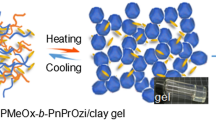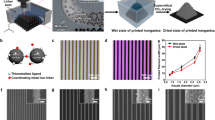Abstract
Bio-inspired ceramics, that can overcome the brittleness of ceramics, require building blocks with thickness of a few hundred nanometers. It is extremely challenging to precisely fabricate the building blocks for the bio-inspired ceramics. In this paper, we demonstrate the processing of dense mullite nano-ribbons, using the sol–gel inkjet printing method with post-heat treatment. These nano-ribbons had precisely controllable dimensions of sub-micrometer thickness and width of a few hundred of micrometers. A novel single-phase ink from the water-based mullite sol–gel precursor was developed that ensured inkjet printability and low-temperature formation of pure mullite phase. One of the greatest challenges was how to achieve uniform track from such inks, because the sol–gel inks had non-zero receding contact angles with the substrate. According to previous theoretical studies, the ink track would eventually become discrete beads. However, we found that solvent-evaporation-induced gelation played an important role in the stability of the printed lines. Taking advantage of the solvent evaporation and sol–gel transition upon substrate heating, we were able to print stable and continuous gel lines. After firing these printed lines at 1000 °C, the pure mullite phase without any undesirable intermediate phases was achieved. The printed lines and dots retained their shapes during firing. It is shown that the crack-free mullite nano-ribbons of the thickness ranging between ~90 and ~200 nm can be printed directly on substrates.

Highlights
-
Dense and crack free mullite nano ribbons were inkjet-printed using the sol-gel inks.
-
A novel single-phase ink from water-based mullite sol-gel precursor was developed that ensured inkjet printability and low-temperature formation of pure mullite phase.
-
Stable and countinuous gel lines was printed by takng advantage of the solvent evaporation and sol-gel transition upon substrate heating, which has not been predicted by theoretical studies.















Similar content being viewed by others
References
Munch E, Launey ME, Alsem DH, Saiz E, Tomsia AP, Ritchie RO (2008) Tough, bio-inspired hybrid materials. Science 322(5907):1516–1520
Studart AR (2014) Bioinspired ceramics: turning brittleness into toughness. Nat Mater 13(5):433–435
Ritchie RO (2011) The conflicts between strength and toughness. Nat Mater 10(11):817–822
Deckers J, Vleugels J, Kruthl JP (2014) Additive manufacturing of ceramics: a review. J Ceram Sci Technol 5(4):245–260
Travitzky N, Bonet A, Dermeik B, Fey T, Filbert-Demut I, Schlier L, Schlordt T, Greil P (2014) Additive manufacturing of ceramic-based materials. Adv Eng Mater 16(6):729–754
Eckel ZC, Zhou CY, Martin JH, Jacobsen AJ, Carter WB, Schaedler TA (2016) 3D PRINTING additive manufacturing of polymer-derived ceramics. Science 351(6268):58–62
Chen ZY, Song X, Lei LW, Chen XY, Fei CL, Chiu CT, Qian XJ, Ma T, Yang Y, Shung K, Chen Y, Zhou QF (2016) 3D printing of piezoelectric element for energy focusing and ultrasonic sensing. Nano Energy 27:78–86
Derby B (2015) Additive manufacture of ceramics components by inkjet printing. Engineering 1(1):113–123
Lewis JA, Smay JE, Stuecker J, Cesarano J (2006) Direct ink writing of three-dimensional ceramic structures. J Am Ceram Soc 89(12):3599–3609
Zocca A, Colombo P, Gomes CM, Gunster J (2015) Additive manufacturing of ceramics: issues, potentialities, and opportunities. J Am Ceram Soc 98(7):1983–2001
Sachs E, Cima M, Williams P, Brancazio D, Cornie J (1992) Three dimensional printing: rapid tooling and prototypes directly from a CAD model. J Eng Ind 114(4):481–488
Zhao XL, Evans JRG, Edirisinghe MJ, Song JH (2002) Direct ink-jet printing of vertical walls. J Am Ceram Soc 85(8):2113–2115
Dou R, Wang TM, Guo YS, Derby B (2011) Ink-jet printing of zirconia: coffee staining and line stability. J Am Ceram Soc 94(11):3787–3792
Oh Y, Yoon HG, Lee SN, Kim HK, Kim J (2012) Inkjet-printing of TiO2 co-solvent ink: from uniform ink-droplet to TiO2 photoelectrode for dye-sensitized solar cells. J Electrochem Soc 159(1):B35–B39
Reis N, Ainsley C, Derby B (2005) Viscosity and acoustic behavior of ceramic suspensions optimized for phase-change ink-jet printing. J Am Ceram Soc 88(4):802–808
Wang TM, Derby B (2005) Ink-jet printing and sintering of PZT. J Am Ceram Soc 88(8):2053–2058
Seerden KAM, Reis N, Evans JRG, Grant PS, Halloran JW, Derby B (2001) Ink-jet printing of wax-based alumina suspensions. J Am Ceram Soc 84(11):2514–2520
Hahn H, Logas J, Averback RS (1990) Sintering characteristics of nanocrystalline TiO2. J Mater Res 5(3):609–614
Luan W, Gao L, Guo J (1999) Size effect on dielectric properties of fine-grained BaTiO3 ceramics. Ceram Int 25(8):727–729
Brinker CJ, Scherer GW (2013) Sol-gel science: the physics and chemistry of sol-gel processing. New York, Academic Press
Chen ZX, Zhang Z, Tsai CC, Kornev K, Luzinov I, Fang MH, Peng F (2015) Electrospun mullite fibers from the sol-gel precursor. J Sol-Gel Sci Technol 74(1):208–219
Chen ZX, Burtovyy R, Kornev K, Luzinov I, Xu D, Peng F (2016) The effect of polymer additives on the critical thicknesses of mullite thin films obtained from the monophasic sol-gel precursors. J Sol-Gel Sci Technol 80(2):285–296
Chen ZX, Burtovyy R, Kornev KG, Luzinov I, Peng F (2017) Dense and crack-free mullite films obtained from a hybrid sol-gel/dip-coating approach. J Mater Res 32(9):1665–1673
Chen ZX, Gu Y, Aprelev P, Kornev K, Luzinov I, Chen J, Peng F (2016) Mullite-nickel magnetic nanocomposite fibers obtained from electrospinning followed by thermal reduction. J Am Ceram Soc 99(5):1504–1511
Kanzaki S, Tabata H, Kumazawa T, Ohta S (1985) Sintering and mechanical properties of stoichiometric mullite. J Am Ceram Soc 68(1):C6–C7
Atkinson A, Doorbar J, Hudd A, Segal DL, White PJ (1997) Continuous ink-jet printing using sol-gel “ceramic” inks. J Sol-Gel Sci Technol 8(1–3):1093–1097
Chouiki M, Schoeftner R (2011) Inkjet printing of inorganic sol-gel ink and control of the geometrical characteristics. J Sol-Gel Sci Technol 58(1):91–95
Aksay IA, Dabbs DM, Sarikaya M (1991) Mullite for structural, electronic, and optical applications. J Am Ceram Soc 74(10):2343–2358
Kriven W, Palko J, Sinogeikin S, Bass JD, Sayir A, Brunauer G, Boysen H, Frey F, Schneider J (1999) High temperature single crystal properties of mullite. J Eur Ceram Soc 19(13–14):2529–2541
Dokko PC, Pask JA, Mazdiyasni KS (1977) High-temperature mechanical-properties of mullite under compression. J Am Ceram Soc 60(3–4):150–155
Chen ZX, Gu Y, Zhang Z, Kornev KG, Luzinov I, Peng F (2015) Measuring flexural rigidity of mullite microfibers using magnetic droplets. J Appl Phys 117(21):214304
Derby B (2011) Inkjet printing ceramics: from drops to solid. J Eur Ceram Soc 31(14):2543–2550
Stringer J, Derby B (2010) Formation and stability of lines produced by inkjet printing. Langmuir 26(12):10365–10372
Davis SH (1980) Moving contact lines and rivulet instabilities.1. The static rivulet. J Fluid Mech 98:225–242
Schiaffino S, Sonin AA (1997) Formation and stability of liquid and molten beads on a solid surface. J Fluid Mech 343:95–110
Duineveld PC (2003) The stability of ink-jet printed lines of liquid with zero receding contact angle on a homogeneous substrate. J Fluid Mech 477:175–200
Benilov E (2009) On the stability of shallow rivulets. J Fluid Mech 636:455–474
Hong Y, Chen Z, Trofimov AA, Lei J, Chen J, Yuan L, Zhu W, Xiao H, Xu D, Jacobsohn LG (2017) Direct inkjet printing of miniaturized luminescent YAG: Er3+ from sol-gel precursor. Opt Mater 68:11–18
Soltman D, Subramanian V (2008) Inkjet-printed line morphologies and temperature control of the coffee ring effect. Langmuir 24(5):2224–2231
Gu Y, Chen Z, Borodinov N, Luzinov I, Peng F, Kornev KG (2014) Kinetics of evaporation and gel formation in thin films of ceramic precursors. Langmuir 30(48):14638–14647
Kozuka H, Kajimura M (2000) Single-step dip coating of crack-free BaTiO3 films >1 mu m thick: effect of poly(vinylpyrrolidone) on critical thickness. J Am Ceram Soc 83(5):1056–1062
Acknowledgements
The authors would like to appreciate the funding support from NIH: SC TRIMH COBRE 1P20GM130451.
Author information
Authors and Affiliations
Corresponding author
Ethics declarations
Conflict of interest
The authors declare that they have no conflict of interest.
Additional information
Publisher’s note Springer Nature remains neutral with regard to jurisdictional claims in published maps and institutional affiliations.
Rights and permissions
About this article
Cite this article
Hong, Y., Chen, Z., Lei, J. et al. Direct inkjet printing of mullite nano-ribbons from the sol–gel precursor. J Sol-Gel Sci Technol 95, 66–76 (2020). https://doi.org/10.1007/s10971-020-05301-3
Received:
Accepted:
Published:
Issue Date:
DOI: https://doi.org/10.1007/s10971-020-05301-3




